Federation Uni: BUACC3706 - Financial Accounting Code Comparison
VerifiedAdded on 2022/11/28
|14
|3983
|418
Essay
AI Summary
This essay provides a comprehensive comparison of two key Australian codes: the 'Australian Banking Code of Practice' and the 'Code of Ethics for Professional Accountants'. It explores their similarities, such as their shared goal of upholding professional practice standards, while also highlighting their differences, including the voluntary versus mandatory nature of their adoption and the specific groups they apply to. The essay delves into the justification for each code, examining the need for the Banking Code in protecting customers and promoting ethical behavior within the banking sector, and the necessity of the Code of Ethics for Accountants in ensuring ethical conduct within the accounting profession. Furthermore, the paper discusses the likelihood of success for each code, considering their implementation and impact on the respective industries. The analysis includes references to the 'APES 110 Code of Ethics for Professional Accountants' and the standards outlined by the Australian Banking Association, emphasizing the codes' roles in promoting transparency, accountability, and ethical practices within the financial sector.
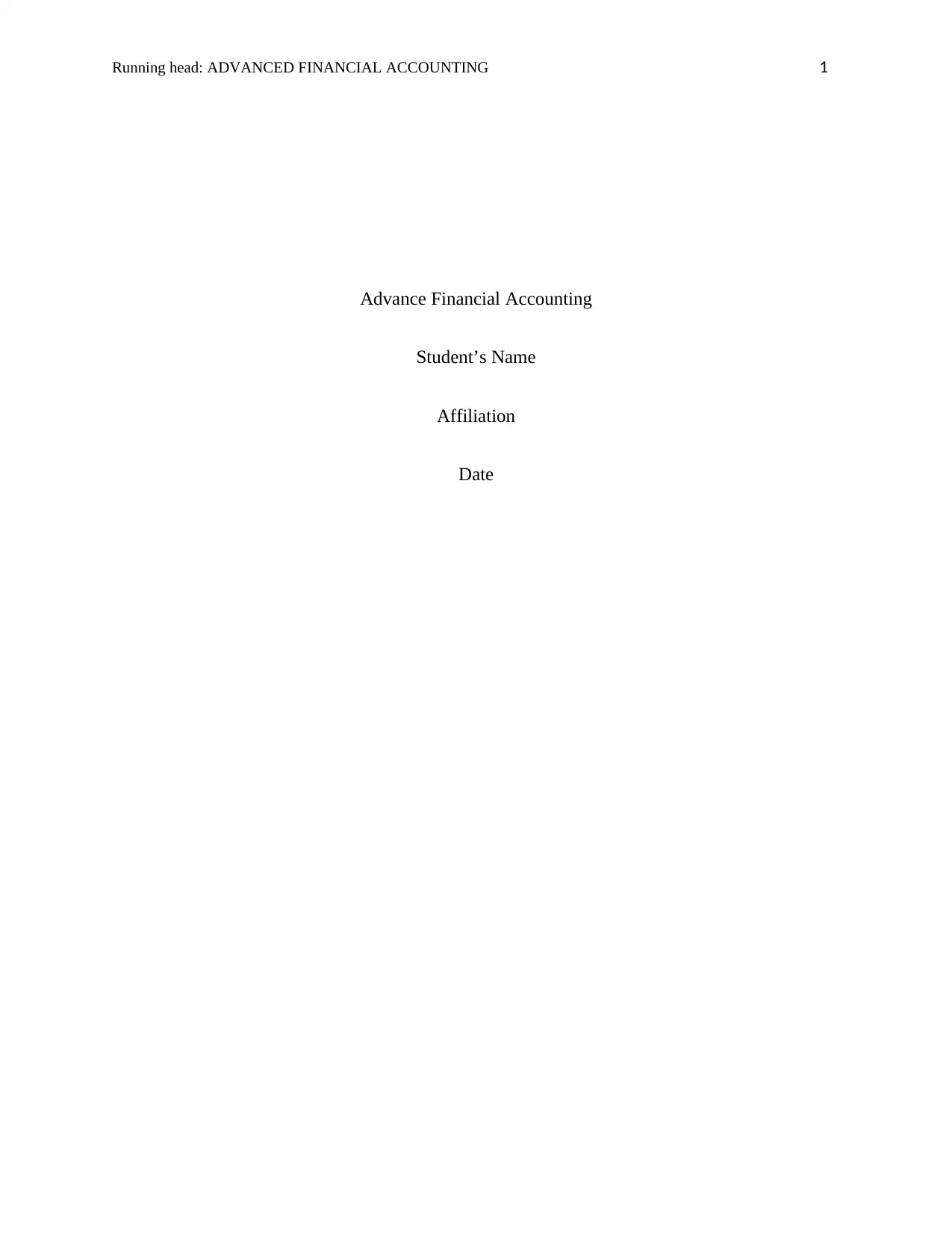
Running head: ADVANCED FINANCIAL ACCOUNTING 1
Advance Financial Accounting
Student’s Name
Affiliation
Date
Advance Financial Accounting
Student’s Name
Affiliation
Date
Paraphrase This Document
Need a fresh take? Get an instant paraphrase of this document with our AI Paraphraser
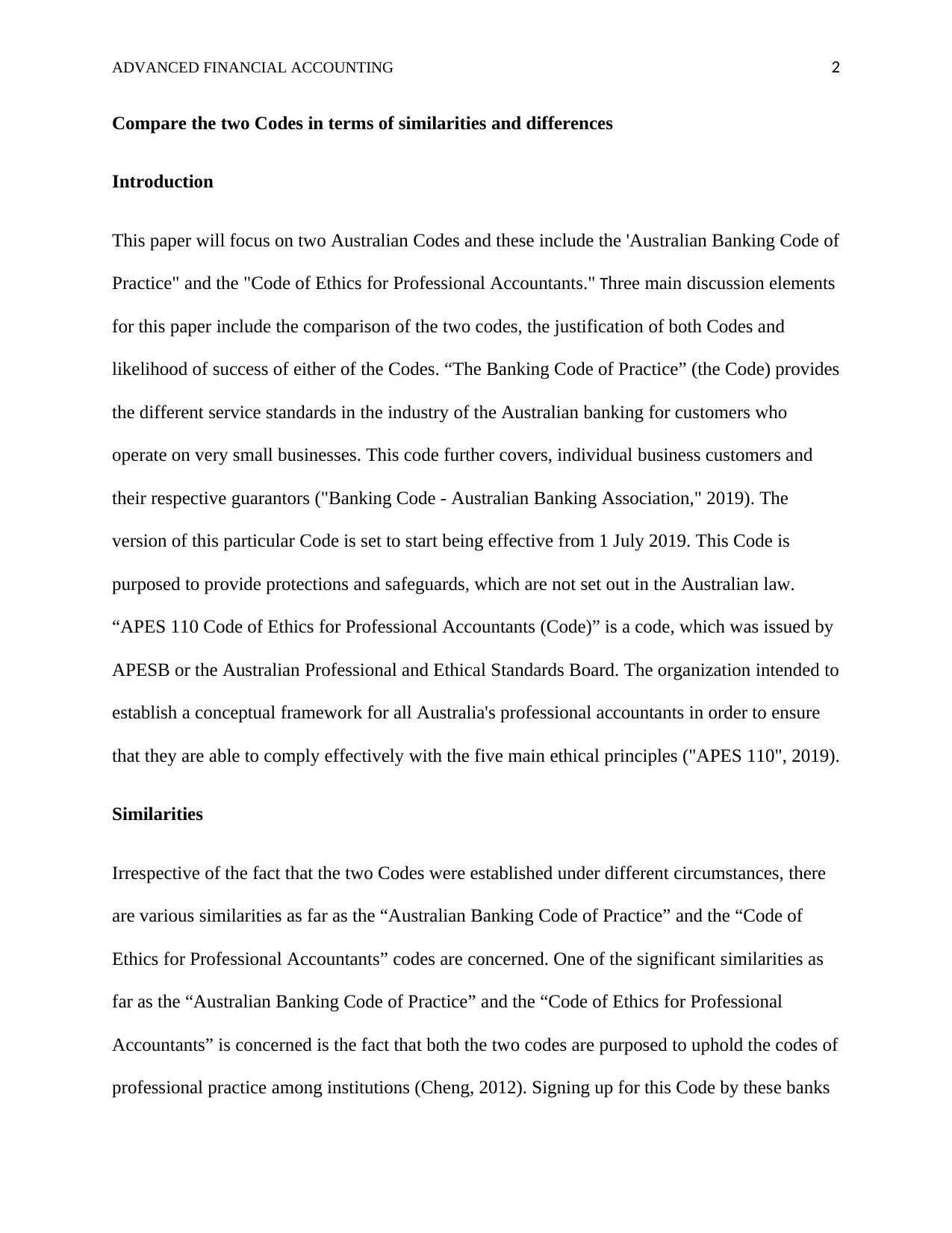
ADVANCED FINANCIAL ACCOUNTING 2
Compare the two Codes in terms of similarities and differences
Introduction
This paper will focus on two Australian Codes and these include the 'Australian Banking Code of
Practice" and the "Code of Ethics for Professional Accountants." Three main discussion elements
for this paper include the comparison of the two codes, the justification of both Codes and
likelihood of success of either of the Codes. “The Banking Code of Practice” (the Code) provides
the different service standards in the industry of the Australian banking for customers who
operate on very small businesses. This code further covers, individual business customers and
their respective guarantors ("Banking Code - Australian Banking Association," 2019). The
version of this particular Code is set to start being effective from 1 July 2019. This Code is
purposed to provide protections and safeguards, which are not set out in the Australian law.
“APES 110 Code of Ethics for Professional Accountants (Code)” is a code, which was issued by
APESB or the Australian Professional and Ethical Standards Board. The organization intended to
establish a conceptual framework for all Australia's professional accountants in order to ensure
that they are able to comply effectively with the five main ethical principles ("APES 110", 2019).
Similarities
Irrespective of the fact that the two Codes were established under different circumstances, there
are various similarities as far as the “Australian Banking Code of Practice” and the “Code of
Ethics for Professional Accountants” codes are concerned. One of the significant similarities as
far as the “Australian Banking Code of Practice” and the “Code of Ethics for Professional
Accountants” is concerned is the fact that both the two codes are purposed to uphold the codes of
professional practice among institutions (Cheng, 2012). Signing up for this Code by these banks
Compare the two Codes in terms of similarities and differences
Introduction
This paper will focus on two Australian Codes and these include the 'Australian Banking Code of
Practice" and the "Code of Ethics for Professional Accountants." Three main discussion elements
for this paper include the comparison of the two codes, the justification of both Codes and
likelihood of success of either of the Codes. “The Banking Code of Practice” (the Code) provides
the different service standards in the industry of the Australian banking for customers who
operate on very small businesses. This code further covers, individual business customers and
their respective guarantors ("Banking Code - Australian Banking Association," 2019). The
version of this particular Code is set to start being effective from 1 July 2019. This Code is
purposed to provide protections and safeguards, which are not set out in the Australian law.
“APES 110 Code of Ethics for Professional Accountants (Code)” is a code, which was issued by
APESB or the Australian Professional and Ethical Standards Board. The organization intended to
establish a conceptual framework for all Australia's professional accountants in order to ensure
that they are able to comply effectively with the five main ethical principles ("APES 110", 2019).
Similarities
Irrespective of the fact that the two Codes were established under different circumstances, there
are various similarities as far as the “Australian Banking Code of Practice” and the “Code of
Ethics for Professional Accountants” codes are concerned. One of the significant similarities as
far as the “Australian Banking Code of Practice” and the “Code of Ethics for Professional
Accountants” is concerned is the fact that both the two codes are purposed to uphold the codes of
professional practice among institutions (Cheng, 2012). Signing up for this Code by these banks
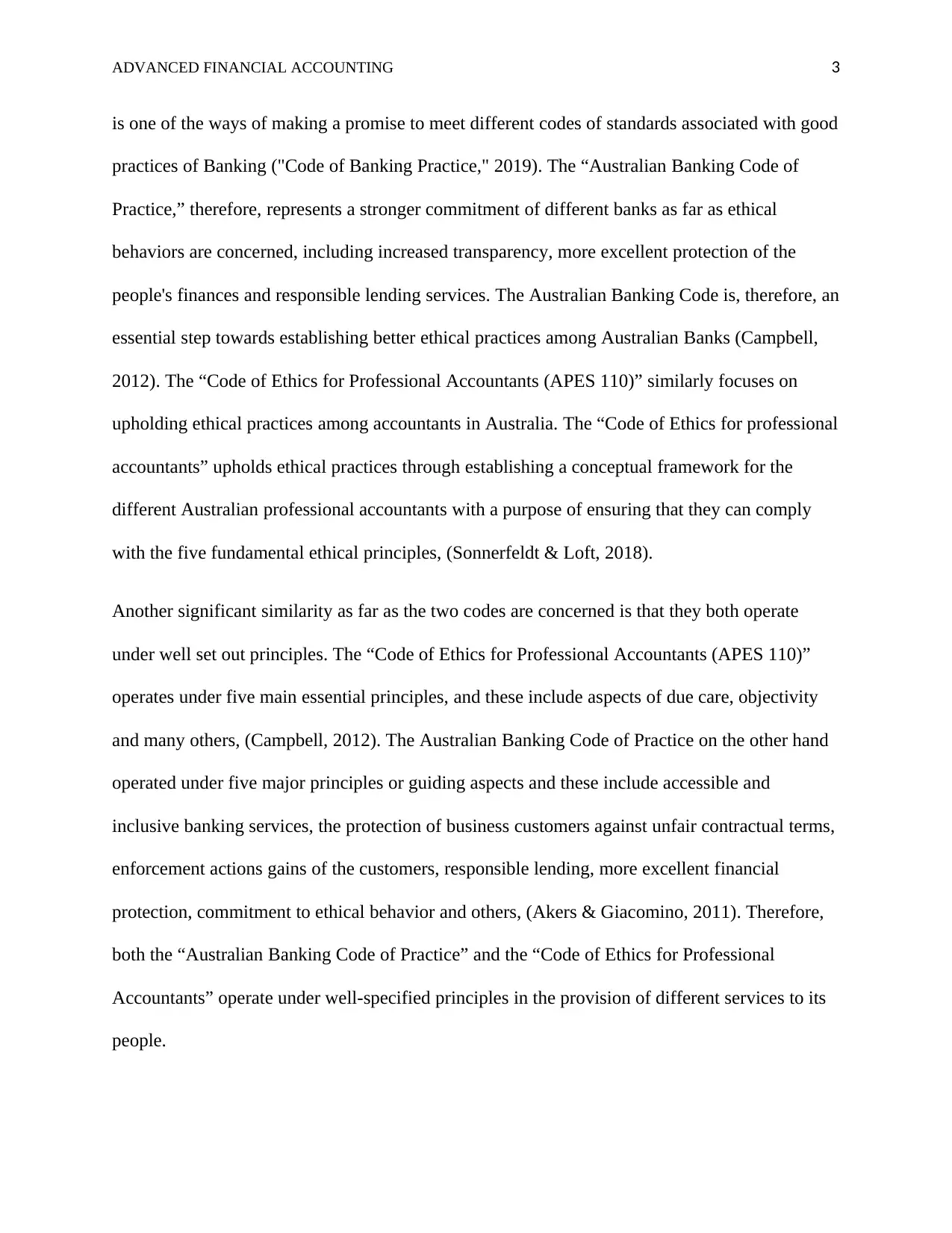
ADVANCED FINANCIAL ACCOUNTING 3
is one of the ways of making a promise to meet different codes of standards associated with good
practices of Banking ("Code of Banking Practice," 2019). The “Australian Banking Code of
Practice,” therefore, represents a stronger commitment of different banks as far as ethical
behaviors are concerned, including increased transparency, more excellent protection of the
people's finances and responsible lending services. The Australian Banking Code is, therefore, an
essential step towards establishing better ethical practices among Australian Banks (Campbell,
2012). The “Code of Ethics for Professional Accountants (APES 110)” similarly focuses on
upholding ethical practices among accountants in Australia. The “Code of Ethics for professional
accountants” upholds ethical practices through establishing a conceptual framework for the
different Australian professional accountants with a purpose of ensuring that they can comply
with the five fundamental ethical principles, (Sonnerfeldt & Loft, 2018).
Another significant similarity as far as the two codes are concerned is that they both operate
under well set out principles. The “Code of Ethics for Professional Accountants (APES 110)”
operates under five main essential principles, and these include aspects of due care, objectivity
and many others, (Campbell, 2012). The Australian Banking Code of Practice on the other hand
operated under five major principles or guiding aspects and these include accessible and
inclusive banking services, the protection of business customers against unfair contractual terms,
enforcement actions gains of the customers, responsible lending, more excellent financial
protection, commitment to ethical behavior and others, (Akers & Giacomino, 2011). Therefore,
both the “Australian Banking Code of Practice” and the “Code of Ethics for Professional
Accountants” operate under well-specified principles in the provision of different services to its
people.
is one of the ways of making a promise to meet different codes of standards associated with good
practices of Banking ("Code of Banking Practice," 2019). The “Australian Banking Code of
Practice,” therefore, represents a stronger commitment of different banks as far as ethical
behaviors are concerned, including increased transparency, more excellent protection of the
people's finances and responsible lending services. The Australian Banking Code is, therefore, an
essential step towards establishing better ethical practices among Australian Banks (Campbell,
2012). The “Code of Ethics for Professional Accountants (APES 110)” similarly focuses on
upholding ethical practices among accountants in Australia. The “Code of Ethics for professional
accountants” upholds ethical practices through establishing a conceptual framework for the
different Australian professional accountants with a purpose of ensuring that they can comply
with the five fundamental ethical principles, (Sonnerfeldt & Loft, 2018).
Another significant similarity as far as the two codes are concerned is that they both operate
under well set out principles. The “Code of Ethics for Professional Accountants (APES 110)”
operates under five main essential principles, and these include aspects of due care, objectivity
and many others, (Campbell, 2012). The Australian Banking Code of Practice on the other hand
operated under five major principles or guiding aspects and these include accessible and
inclusive banking services, the protection of business customers against unfair contractual terms,
enforcement actions gains of the customers, responsible lending, more excellent financial
protection, commitment to ethical behavior and others, (Akers & Giacomino, 2011). Therefore,
both the “Australian Banking Code of Practice” and the “Code of Ethics for Professional
Accountants” operate under well-specified principles in the provision of different services to its
people.
⊘ This is a preview!⊘
Do you want full access?
Subscribe today to unlock all pages.

Trusted by 1+ million students worldwide
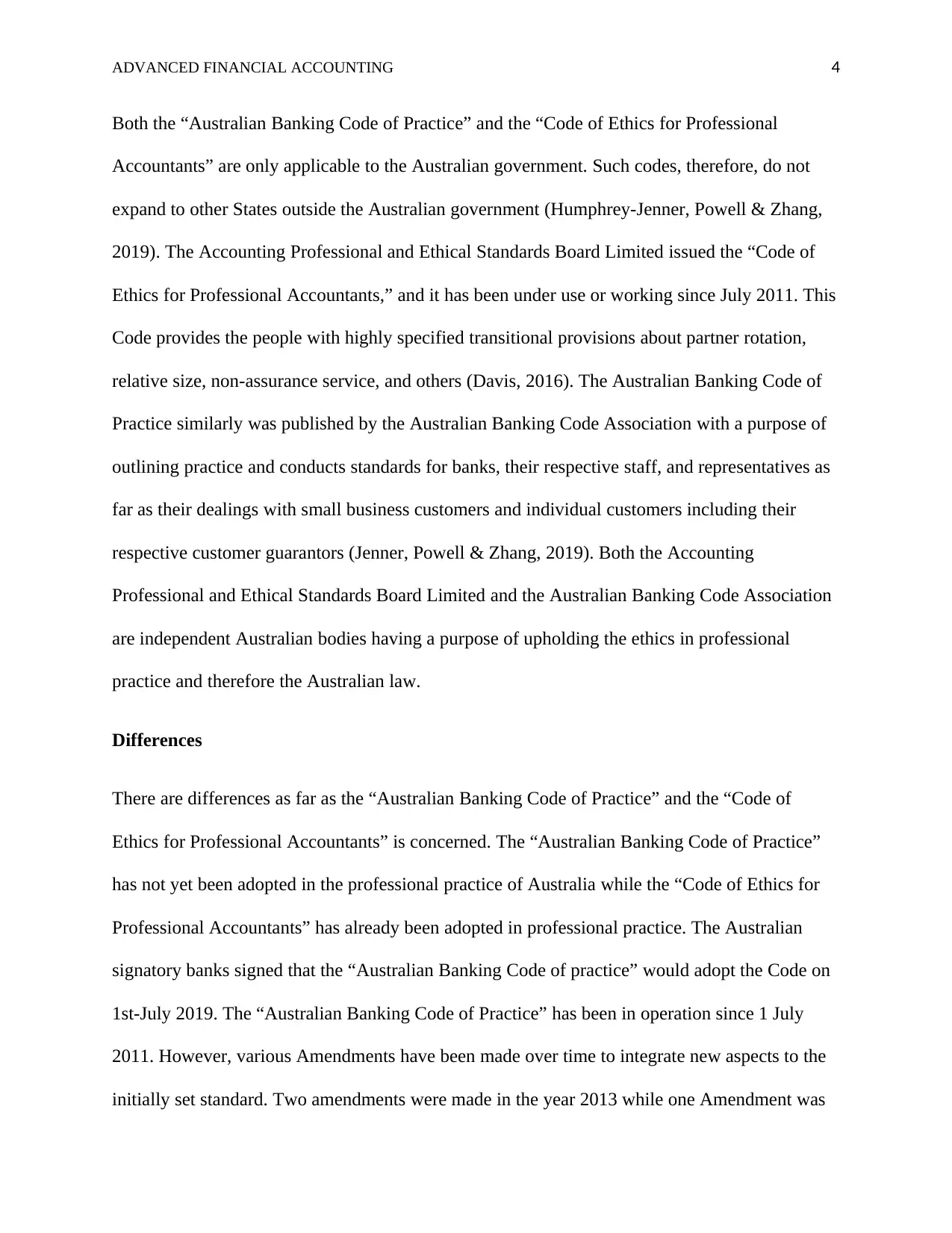
ADVANCED FINANCIAL ACCOUNTING 4
Both the “Australian Banking Code of Practice” and the “Code of Ethics for Professional
Accountants” are only applicable to the Australian government. Such codes, therefore, do not
expand to other States outside the Australian government (Humphrey-Jenner, Powell & Zhang,
2019). The Accounting Professional and Ethical Standards Board Limited issued the “Code of
Ethics for Professional Accountants,” and it has been under use or working since July 2011. This
Code provides the people with highly specified transitional provisions about partner rotation,
relative size, non-assurance service, and others (Davis, 2016). The Australian Banking Code of
Practice similarly was published by the Australian Banking Code Association with a purpose of
outlining practice and conducts standards for banks, their respective staff, and representatives as
far as their dealings with small business customers and individual customers including their
respective customer guarantors (Jenner, Powell & Zhang, 2019). Both the Accounting
Professional and Ethical Standards Board Limited and the Australian Banking Code Association
are independent Australian bodies having a purpose of upholding the ethics in professional
practice and therefore the Australian law.
Differences
There are differences as far as the “Australian Banking Code of Practice” and the “Code of
Ethics for Professional Accountants” is concerned. The “Australian Banking Code of Practice”
has not yet been adopted in the professional practice of Australia while the “Code of Ethics for
Professional Accountants” has already been adopted in professional practice. The Australian
signatory banks signed that the “Australian Banking Code of practice” would adopt the Code on
1st-July 2019. The “Australian Banking Code of Practice” has been in operation since 1 July
2011. However, various Amendments have been made over time to integrate new aspects to the
initially set standard. Two amendments were made in the year 2013 while one Amendment was
Both the “Australian Banking Code of Practice” and the “Code of Ethics for Professional
Accountants” are only applicable to the Australian government. Such codes, therefore, do not
expand to other States outside the Australian government (Humphrey-Jenner, Powell & Zhang,
2019). The Accounting Professional and Ethical Standards Board Limited issued the “Code of
Ethics for Professional Accountants,” and it has been under use or working since July 2011. This
Code provides the people with highly specified transitional provisions about partner rotation,
relative size, non-assurance service, and others (Davis, 2016). The Australian Banking Code of
Practice similarly was published by the Australian Banking Code Association with a purpose of
outlining practice and conducts standards for banks, their respective staff, and representatives as
far as their dealings with small business customers and individual customers including their
respective customer guarantors (Jenner, Powell & Zhang, 2019). Both the Accounting
Professional and Ethical Standards Board Limited and the Australian Banking Code Association
are independent Australian bodies having a purpose of upholding the ethics in professional
practice and therefore the Australian law.
Differences
There are differences as far as the “Australian Banking Code of Practice” and the “Code of
Ethics for Professional Accountants” is concerned. The “Australian Banking Code of Practice”
has not yet been adopted in the professional practice of Australia while the “Code of Ethics for
Professional Accountants” has already been adopted in professional practice. The Australian
signatory banks signed that the “Australian Banking Code of practice” would adopt the Code on
1st-July 2019. The “Australian Banking Code of Practice” has been in operation since 1 July
2011. However, various Amendments have been made over time to integrate new aspects to the
initially set standard. Two amendments were made in the year 2013 while one Amendment was
Paraphrase This Document
Need a fresh take? Get an instant paraphrase of this document with our AI Paraphraser
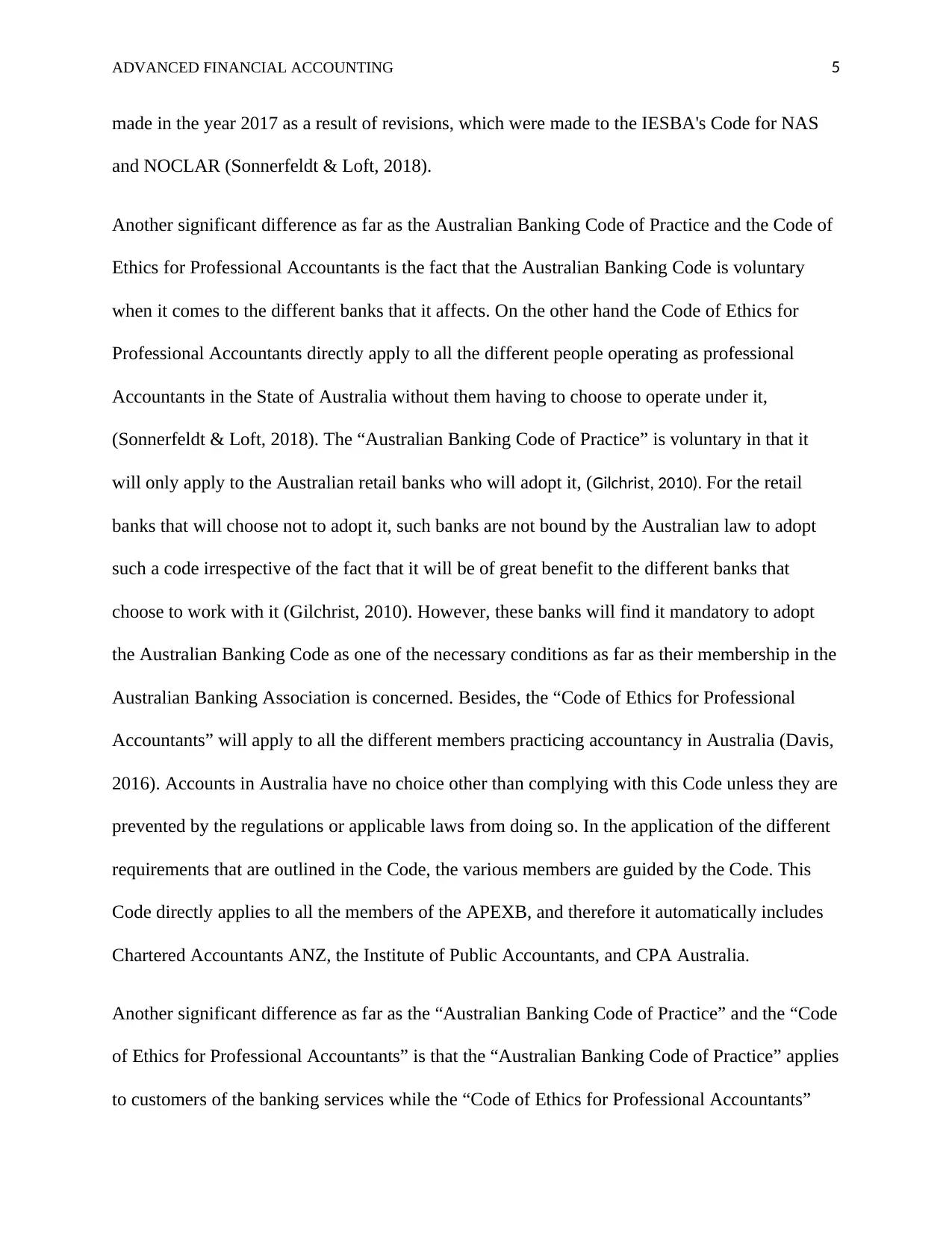
ADVANCED FINANCIAL ACCOUNTING 5
made in the year 2017 as a result of revisions, which were made to the IESBA's Code for NAS
and NOCLAR (Sonnerfeldt & Loft, 2018).
Another significant difference as far as the Australian Banking Code of Practice and the Code of
Ethics for Professional Accountants is the fact that the Australian Banking Code is voluntary
when it comes to the different banks that it affects. On the other hand the Code of Ethics for
Professional Accountants directly apply to all the different people operating as professional
Accountants in the State of Australia without them having to choose to operate under it,
(Sonnerfeldt & Loft, 2018). The “Australian Banking Code of Practice” is voluntary in that it
will only apply to the Australian retail banks who will adopt it, (Gilchrist, 2010). For the retail
banks that will choose not to adopt it, such banks are not bound by the Australian law to adopt
such a code irrespective of the fact that it will be of great benefit to the different banks that
choose to work with it (Gilchrist, 2010). However, these banks will find it mandatory to adopt
the Australian Banking Code as one of the necessary conditions as far as their membership in the
Australian Banking Association is concerned. Besides, the “Code of Ethics for Professional
Accountants” will apply to all the different members practicing accountancy in Australia (Davis,
2016). Accounts in Australia have no choice other than complying with this Code unless they are
prevented by the regulations or applicable laws from doing so. In the application of the different
requirements that are outlined in the Code, the various members are guided by the Code. This
Code directly applies to all the members of the APEXB, and therefore it automatically includes
Chartered Accountants ANZ, the Institute of Public Accountants, and CPA Australia.
Another significant difference as far as the “Australian Banking Code of Practice” and the “Code
of Ethics for Professional Accountants” is that the “Australian Banking Code of Practice” applies
to customers of the banking services while the “Code of Ethics for Professional Accountants”
made in the year 2017 as a result of revisions, which were made to the IESBA's Code for NAS
and NOCLAR (Sonnerfeldt & Loft, 2018).
Another significant difference as far as the Australian Banking Code of Practice and the Code of
Ethics for Professional Accountants is the fact that the Australian Banking Code is voluntary
when it comes to the different banks that it affects. On the other hand the Code of Ethics for
Professional Accountants directly apply to all the different people operating as professional
Accountants in the State of Australia without them having to choose to operate under it,
(Sonnerfeldt & Loft, 2018). The “Australian Banking Code of Practice” is voluntary in that it
will only apply to the Australian retail banks who will adopt it, (Gilchrist, 2010). For the retail
banks that will choose not to adopt it, such banks are not bound by the Australian law to adopt
such a code irrespective of the fact that it will be of great benefit to the different banks that
choose to work with it (Gilchrist, 2010). However, these banks will find it mandatory to adopt
the Australian Banking Code as one of the necessary conditions as far as their membership in the
Australian Banking Association is concerned. Besides, the “Code of Ethics for Professional
Accountants” will apply to all the different members practicing accountancy in Australia (Davis,
2016). Accounts in Australia have no choice other than complying with this Code unless they are
prevented by the regulations or applicable laws from doing so. In the application of the different
requirements that are outlined in the Code, the various members are guided by the Code. This
Code directly applies to all the members of the APEXB, and therefore it automatically includes
Chartered Accountants ANZ, the Institute of Public Accountants, and CPA Australia.
Another significant difference as far as the “Australian Banking Code of Practice” and the “Code
of Ethics for Professional Accountants” is that the “Australian Banking Code of Practice” applies
to customers of the banking services while the “Code of Ethics for Professional Accountants”

ADVANCED FINANCIAL ACCOUNTING 6
applies to bank service [providers or professional accountants. The Australian Banking Code of
Practice majorly applies to all the Australian people who may be or are being provided with
banking services. Among such individuals, include the Individual Australian customers, the
Australian small business customers having less than an amount of $10 m as its annual turnover,
less those 100 FTE workers or employees and overall debt of less than $3m in their previous
financial year. More so, this Code further applies to the prospective guarantors who are securing
a loan in Australia to a small business customer or an individual. The “Code of Ethics for
Professional Accountants,” on the other hand, applies to all the Australian professional
Accountants. This Code sets out different professional standard ns ethics for individuals in the
accounting professional cross Australia and therefore, requires all professional accountants in
Australia to conduct their respective professional activities in the best way they can.
Justification of the codes
Australian Banking Code of Practice
There are several reasons why the Australian Banking Code of Practice was created. The
previous Banking Practices, as far as the Australian government is concerned had limited
consideration for the customer’s needs and banking services that they were provided (Kofman &
Murawski, 2015). Small businesses and customers in the Australian government were not
adequately protected as far as their respective banking services were concerned. This Code was
therefore created to introduce new measures in the Australian government that would play a
significant role in protecting the interest of the banking customers, increase accountability, and
transparency, build confidence and trust in different banks (Kofman & Murawski, 2015). The
legal protections that the bank customer had in Australia were limited, and such customers were
applies to bank service [providers or professional accountants. The Australian Banking Code of
Practice majorly applies to all the Australian people who may be or are being provided with
banking services. Among such individuals, include the Individual Australian customers, the
Australian small business customers having less than an amount of $10 m as its annual turnover,
less those 100 FTE workers or employees and overall debt of less than $3m in their previous
financial year. More so, this Code further applies to the prospective guarantors who are securing
a loan in Australia to a small business customer or an individual. The “Code of Ethics for
Professional Accountants,” on the other hand, applies to all the Australian professional
Accountants. This Code sets out different professional standard ns ethics for individuals in the
accounting professional cross Australia and therefore, requires all professional accountants in
Australia to conduct their respective professional activities in the best way they can.
Justification of the codes
Australian Banking Code of Practice
There are several reasons why the Australian Banking Code of Practice was created. The
previous Banking Practices, as far as the Australian government is concerned had limited
consideration for the customer’s needs and banking services that they were provided (Kofman &
Murawski, 2015). Small businesses and customers in the Australian government were not
adequately protected as far as their respective banking services were concerned. This Code was
therefore created to introduce new measures in the Australian government that would play a
significant role in protecting the interest of the banking customers, increase accountability, and
transparency, build confidence and trust in different banks (Kofman & Murawski, 2015). The
legal protections that the bank customer had in Australia were limited, and such customers were
⊘ This is a preview!⊘
Do you want full access?
Subscribe today to unlock all pages.

Trusted by 1+ million students worldwide

ADVANCED FINANCIAL ACCOUNTING 7
therefore cheated in most cases as the banks provided their respective services. The Australian
Banking Code of Practice was consequently created to enhance the already existing protection of
customers of the Australian Banks through expanding the impact and reach of legal protections
for small businesses and consumers of different Australian Banks (Gruen, 2015).
In addition to the above, there were different areas in the Australian Banking system and
operation that were not covered by banking legislation. Moreover, the Australian legislation was
inappropriate for some particular issues that affected the services provided to different customers
in the Banks (Triyuwono, 2015). Among such areas included the customer rights concerning
account combination, independent rights concerning compliance with other guidelines and
agreements, specific considerations or measure for vulnerable people or groups and the
imposition of different inspirational bank standard(Gruen, 2015). All such issues strongly limited
the quality of bank services that different bank customers were provided as they sought for
services from different banks. The Australian Banking Code of Practice was therefore introduced
to ensure that the rights of bank customers as far as such different areas are concerned were
covered to improve the quality of banking services received by the Australian people. In addition
to the above, the Australian protections that were provided in the NCCPA did not extend to
different small business customers, particularly the aspect of small business loans. Such an issue
created a need for the creation of a Banking code that covered customers irrespective of their
financial status or level (Gruen, 2015). The Australian Banking Code of Practice was, therefore,
created with the intention of coverage was provided for some products and customers that were
not initially afforded coverage as far as the Australian legislation was concerned. More so, this
Banking Code was created to provide body to the legislation's general obligations.
therefore cheated in most cases as the banks provided their respective services. The Australian
Banking Code of Practice was consequently created to enhance the already existing protection of
customers of the Australian Banks through expanding the impact and reach of legal protections
for small businesses and consumers of different Australian Banks (Gruen, 2015).
In addition to the above, there were different areas in the Australian Banking system and
operation that were not covered by banking legislation. Moreover, the Australian legislation was
inappropriate for some particular issues that affected the services provided to different customers
in the Banks (Triyuwono, 2015). Among such areas included the customer rights concerning
account combination, independent rights concerning compliance with other guidelines and
agreements, specific considerations or measure for vulnerable people or groups and the
imposition of different inspirational bank standard(Gruen, 2015). All such issues strongly limited
the quality of bank services that different bank customers were provided as they sought for
services from different banks. The Australian Banking Code of Practice was therefore introduced
to ensure that the rights of bank customers as far as such different areas are concerned were
covered to improve the quality of banking services received by the Australian people. In addition
to the above, the Australian protections that were provided in the NCCPA did not extend to
different small business customers, particularly the aspect of small business loans. Such an issue
created a need for the creation of a Banking code that covered customers irrespective of their
financial status or level (Gruen, 2015). The Australian Banking Code of Practice was, therefore,
created with the intention of coverage was provided for some products and customers that were
not initially afforded coverage as far as the Australian legislation was concerned. More so, this
Banking Code was created to provide body to the legislation's general obligations.
Paraphrase This Document
Need a fresh take? Get an instant paraphrase of this document with our AI Paraphraser
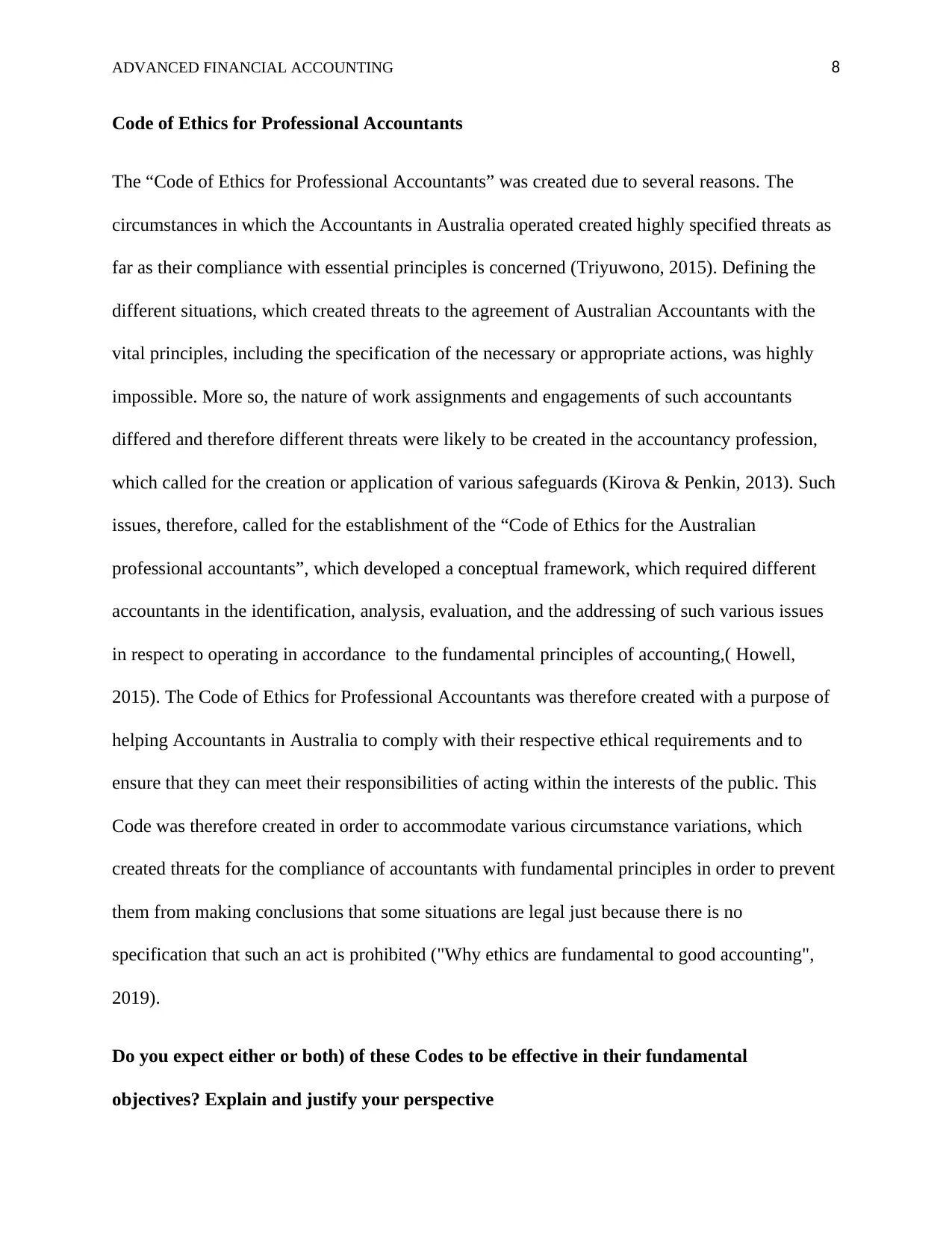
ADVANCED FINANCIAL ACCOUNTING 8
Code of Ethics for Professional Accountants
The “Code of Ethics for Professional Accountants” was created due to several reasons. The
circumstances in which the Accountants in Australia operated created highly specified threats as
far as their compliance with essential principles is concerned (Triyuwono, 2015). Defining the
different situations, which created threats to the agreement of Australian Accountants with the
vital principles, including the specification of the necessary or appropriate actions, was highly
impossible. More so, the nature of work assignments and engagements of such accountants
differed and therefore different threats were likely to be created in the accountancy profession,
which called for the creation or application of various safeguards (Kirova & Penkin, 2013). Such
issues, therefore, called for the establishment of the “Code of Ethics for the Australian
professional accountants”, which developed a conceptual framework, which required different
accountants in the identification, analysis, evaluation, and the addressing of such various issues
in respect to operating in accordance to the fundamental principles of accounting,( Howell,
2015). The Code of Ethics for Professional Accountants was therefore created with a purpose of
helping Accountants in Australia to comply with their respective ethical requirements and to
ensure that they can meet their responsibilities of acting within the interests of the public. This
Code was therefore created in order to accommodate various circumstance variations, which
created threats for the compliance of accountants with fundamental principles in order to prevent
them from making conclusions that some situations are legal just because there is no
specification that such an act is prohibited ("Why ethics are fundamental to good accounting",
2019).
Do you expect either or both) of these Codes to be effective in their fundamental
objectives? Explain and justify your perspective
Code of Ethics for Professional Accountants
The “Code of Ethics for Professional Accountants” was created due to several reasons. The
circumstances in which the Accountants in Australia operated created highly specified threats as
far as their compliance with essential principles is concerned (Triyuwono, 2015). Defining the
different situations, which created threats to the agreement of Australian Accountants with the
vital principles, including the specification of the necessary or appropriate actions, was highly
impossible. More so, the nature of work assignments and engagements of such accountants
differed and therefore different threats were likely to be created in the accountancy profession,
which called for the creation or application of various safeguards (Kirova & Penkin, 2013). Such
issues, therefore, called for the establishment of the “Code of Ethics for the Australian
professional accountants”, which developed a conceptual framework, which required different
accountants in the identification, analysis, evaluation, and the addressing of such various issues
in respect to operating in accordance to the fundamental principles of accounting,( Howell,
2015). The Code of Ethics for Professional Accountants was therefore created with a purpose of
helping Accountants in Australia to comply with their respective ethical requirements and to
ensure that they can meet their responsibilities of acting within the interests of the public. This
Code was therefore created in order to accommodate various circumstance variations, which
created threats for the compliance of accountants with fundamental principles in order to prevent
them from making conclusions that some situations are legal just because there is no
specification that such an act is prohibited ("Why ethics are fundamental to good accounting",
2019).
Do you expect either or both) of these Codes to be effective in their fundamental
objectives? Explain and justify your perspective
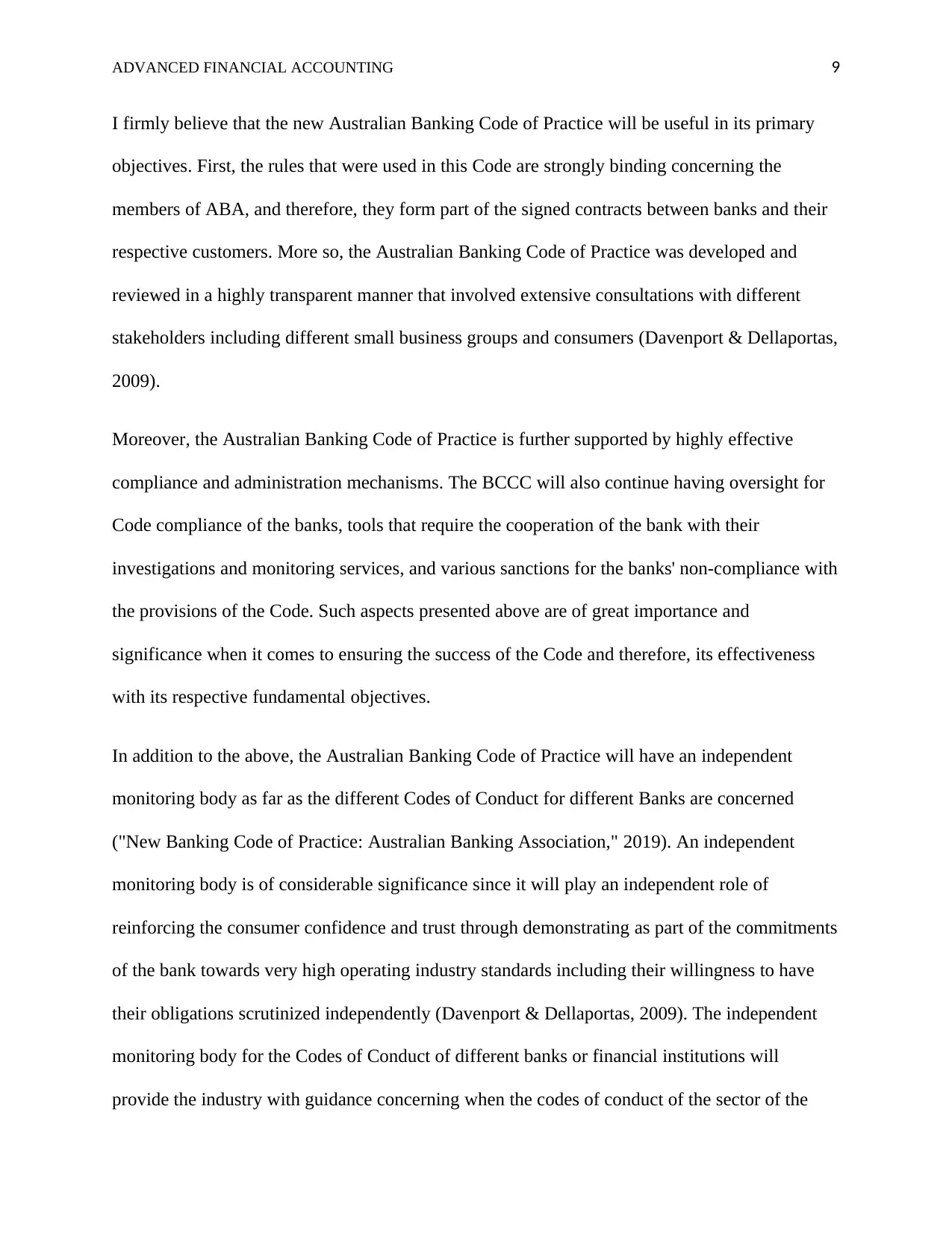
ADVANCED FINANCIAL ACCOUNTING 9
I firmly believe that the new Australian Banking Code of Practice will be useful in its primary
objectives. First, the rules that were used in this Code are strongly binding concerning the
members of ABA, and therefore, they form part of the signed contracts between banks and their
respective customers. More so, the Australian Banking Code of Practice was developed and
reviewed in a highly transparent manner that involved extensive consultations with different
stakeholders including different small business groups and consumers (Davenport & Dellaportas,
2009).
Moreover, the Australian Banking Code of Practice is further supported by highly effective
compliance and administration mechanisms. The BCCC will also continue having oversight for
Code compliance of the banks, tools that require the cooperation of the bank with their
investigations and monitoring services, and various sanctions for the banks' non-compliance with
the provisions of the Code. Such aspects presented above are of great importance and
significance when it comes to ensuring the success of the Code and therefore, its effectiveness
with its respective fundamental objectives.
In addition to the above, the Australian Banking Code of Practice will have an independent
monitoring body as far as the different Codes of Conduct for different Banks are concerned
("New Banking Code of Practice: Australian Banking Association," 2019). An independent
monitoring body is of considerable significance since it will play an independent role of
reinforcing the consumer confidence and trust through demonstrating as part of the commitments
of the bank towards very high operating industry standards including their willingness to have
their obligations scrutinized independently (Davenport & Dellaportas, 2009). The independent
monitoring body for the Codes of Conduct of different banks or financial institutions will
provide the industry with guidance concerning when the codes of conduct of the sector of the
I firmly believe that the new Australian Banking Code of Practice will be useful in its primary
objectives. First, the rules that were used in this Code are strongly binding concerning the
members of ABA, and therefore, they form part of the signed contracts between banks and their
respective customers. More so, the Australian Banking Code of Practice was developed and
reviewed in a highly transparent manner that involved extensive consultations with different
stakeholders including different small business groups and consumers (Davenport & Dellaportas,
2009).
Moreover, the Australian Banking Code of Practice is further supported by highly effective
compliance and administration mechanisms. The BCCC will also continue having oversight for
Code compliance of the banks, tools that require the cooperation of the bank with their
investigations and monitoring services, and various sanctions for the banks' non-compliance with
the provisions of the Code. Such aspects presented above are of great importance and
significance when it comes to ensuring the success of the Code and therefore, its effectiveness
with its respective fundamental objectives.
In addition to the above, the Australian Banking Code of Practice will have an independent
monitoring body as far as the different Codes of Conduct for different Banks are concerned
("New Banking Code of Practice: Australian Banking Association," 2019). An independent
monitoring body is of considerable significance since it will play an independent role of
reinforcing the consumer confidence and trust through demonstrating as part of the commitments
of the bank towards very high operating industry standards including their willingness to have
their obligations scrutinized independently (Davenport & Dellaportas, 2009). The independent
monitoring body for the Codes of Conduct of different banks or financial institutions will
provide the industry with guidance concerning when the codes of conduct of the sector of the
⊘ This is a preview!⊘
Do you want full access?
Subscribe today to unlock all pages.

Trusted by 1+ million students worldwide
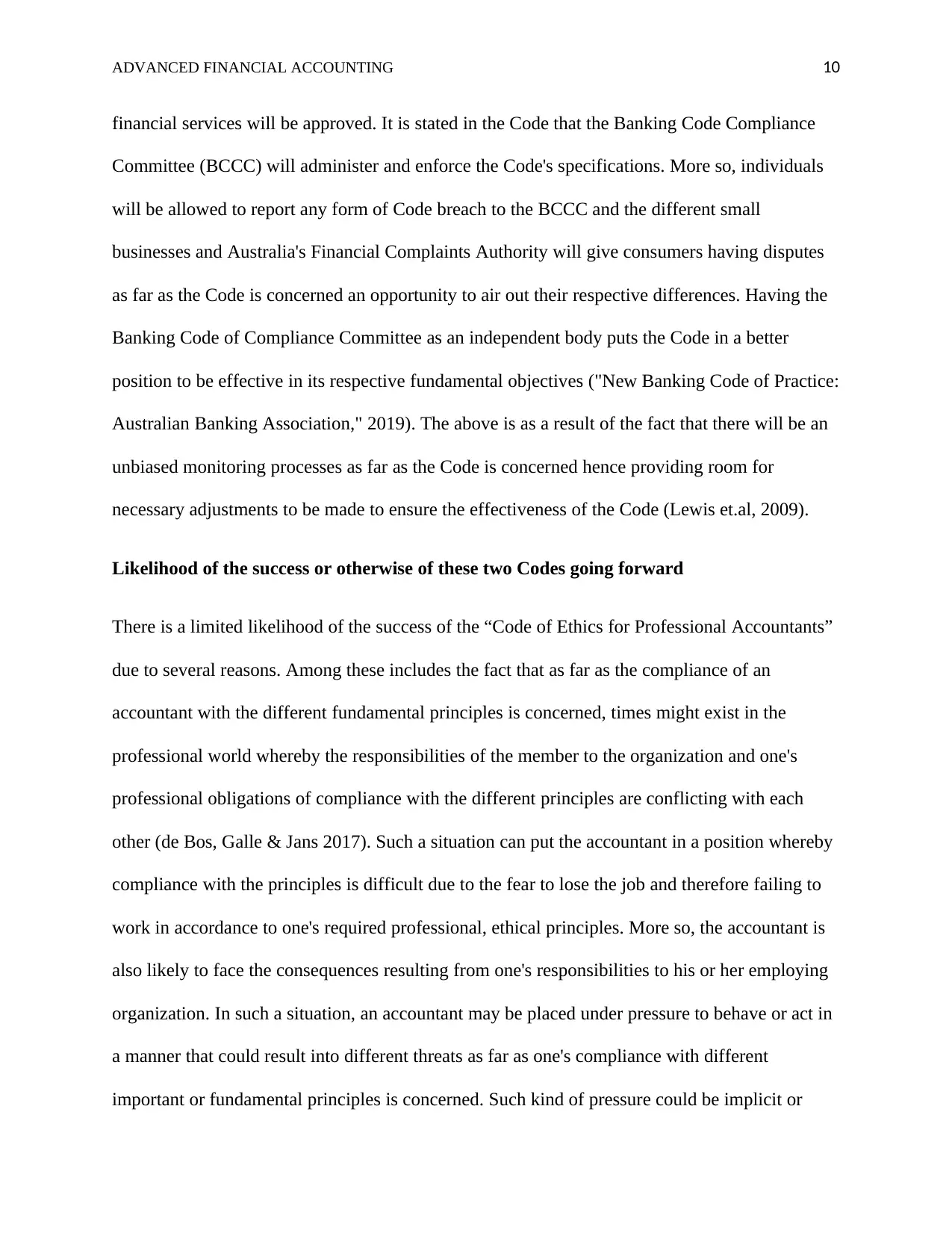
ADVANCED FINANCIAL ACCOUNTING 10
financial services will be approved. It is stated in the Code that the Banking Code Compliance
Committee (BCCC) will administer and enforce the Code's specifications. More so, individuals
will be allowed to report any form of Code breach to the BCCC and the different small
businesses and Australia's Financial Complaints Authority will give consumers having disputes
as far as the Code is concerned an opportunity to air out their respective differences. Having the
Banking Code of Compliance Committee as an independent body puts the Code in a better
position to be effective in its respective fundamental objectives ("New Banking Code of Practice:
Australian Banking Association," 2019). The above is as a result of the fact that there will be an
unbiased monitoring processes as far as the Code is concerned hence providing room for
necessary adjustments to be made to ensure the effectiveness of the Code (Lewis et.al, 2009).
Likelihood of the success or otherwise of these two Codes going forward
There is a limited likelihood of the success of the “Code of Ethics for Professional Accountants”
due to several reasons. Among these includes the fact that as far as the compliance of an
accountant with the different fundamental principles is concerned, times might exist in the
professional world whereby the responsibilities of the member to the organization and one's
professional obligations of compliance with the different principles are conflicting with each
other (de Bos, Galle & Jans 2017). Such a situation can put the accountant in a position whereby
compliance with the principles is difficult due to the fear to lose the job and therefore failing to
work in accordance to one's required professional, ethical principles. More so, the accountant is
also likely to face the consequences resulting from one's responsibilities to his or her employing
organization. In such a situation, an accountant may be placed under pressure to behave or act in
a manner that could result into different threats as far as one's compliance with different
important or fundamental principles is concerned. Such kind of pressure could be implicit or
financial services will be approved. It is stated in the Code that the Banking Code Compliance
Committee (BCCC) will administer and enforce the Code's specifications. More so, individuals
will be allowed to report any form of Code breach to the BCCC and the different small
businesses and Australia's Financial Complaints Authority will give consumers having disputes
as far as the Code is concerned an opportunity to air out their respective differences. Having the
Banking Code of Compliance Committee as an independent body puts the Code in a better
position to be effective in its respective fundamental objectives ("New Banking Code of Practice:
Australian Banking Association," 2019). The above is as a result of the fact that there will be an
unbiased monitoring processes as far as the Code is concerned hence providing room for
necessary adjustments to be made to ensure the effectiveness of the Code (Lewis et.al, 2009).
Likelihood of the success or otherwise of these two Codes going forward
There is a limited likelihood of the success of the “Code of Ethics for Professional Accountants”
due to several reasons. Among these includes the fact that as far as the compliance of an
accountant with the different fundamental principles is concerned, times might exist in the
professional world whereby the responsibilities of the member to the organization and one's
professional obligations of compliance with the different principles are conflicting with each
other (de Bos, Galle & Jans 2017). Such a situation can put the accountant in a position whereby
compliance with the principles is difficult due to the fear to lose the job and therefore failing to
work in accordance to one's required professional, ethical principles. More so, the accountant is
also likely to face the consequences resulting from one's responsibilities to his or her employing
organization. In such a situation, an accountant may be placed under pressure to behave or act in
a manner that could result into different threats as far as one's compliance with different
important or fundamental principles is concerned. Such kind of pressure could be implicit or
Paraphrase This Document
Need a fresh take? Get an instant paraphrase of this document with our AI Paraphraser
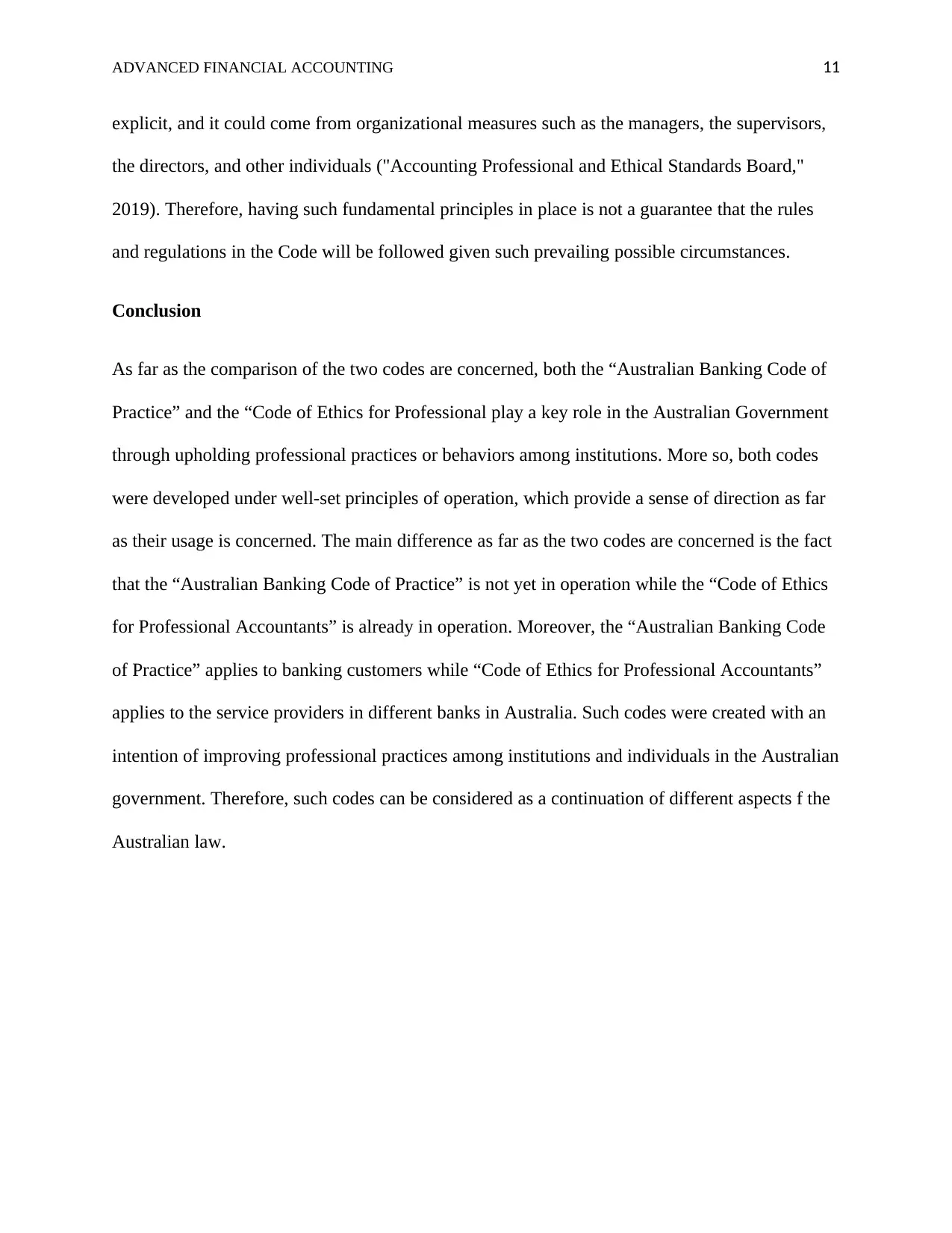
ADVANCED FINANCIAL ACCOUNTING 11
explicit, and it could come from organizational measures such as the managers, the supervisors,
the directors, and other individuals ("Accounting Professional and Ethical Standards Board,"
2019). Therefore, having such fundamental principles in place is not a guarantee that the rules
and regulations in the Code will be followed given such prevailing possible circumstances.
Conclusion
As far as the comparison of the two codes are concerned, both the “Australian Banking Code of
Practice” and the “Code of Ethics for Professional play a key role in the Australian Government
through upholding professional practices or behaviors among institutions. More so, both codes
were developed under well-set principles of operation, which provide a sense of direction as far
as their usage is concerned. The main difference as far as the two codes are concerned is the fact
that the “Australian Banking Code of Practice” is not yet in operation while the “Code of Ethics
for Professional Accountants” is already in operation. Moreover, the “Australian Banking Code
of Practice” applies to banking customers while “Code of Ethics for Professional Accountants”
applies to the service providers in different banks in Australia. Such codes were created with an
intention of improving professional practices among institutions and individuals in the Australian
government. Therefore, such codes can be considered as a continuation of different aspects f the
Australian law.
explicit, and it could come from organizational measures such as the managers, the supervisors,
the directors, and other individuals ("Accounting Professional and Ethical Standards Board,"
2019). Therefore, having such fundamental principles in place is not a guarantee that the rules
and regulations in the Code will be followed given such prevailing possible circumstances.
Conclusion
As far as the comparison of the two codes are concerned, both the “Australian Banking Code of
Practice” and the “Code of Ethics for Professional play a key role in the Australian Government
through upholding professional practices or behaviors among institutions. More so, both codes
were developed under well-set principles of operation, which provide a sense of direction as far
as their usage is concerned. The main difference as far as the two codes are concerned is the fact
that the “Australian Banking Code of Practice” is not yet in operation while the “Code of Ethics
for Professional Accountants” is already in operation. Moreover, the “Australian Banking Code
of Practice” applies to banking customers while “Code of Ethics for Professional Accountants”
applies to the service providers in different banks in Australia. Such codes were created with an
intention of improving professional practices among institutions and individuals in the Australian
government. Therefore, such codes can be considered as a continuation of different aspects f the
Australian law.
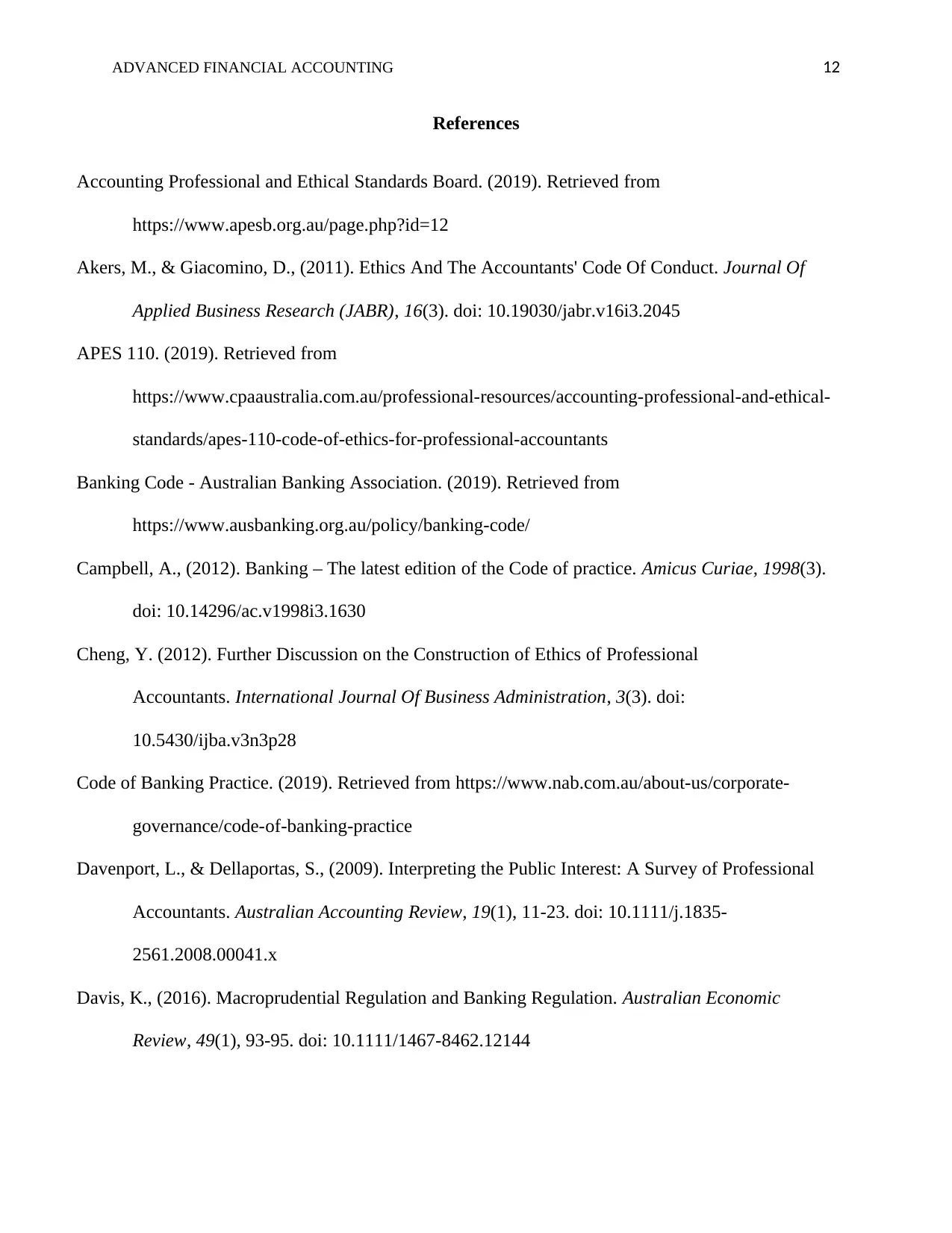
ADVANCED FINANCIAL ACCOUNTING 12
References
Accounting Professional and Ethical Standards Board. (2019). Retrieved from
https://www.apesb.org.au/page.php?id=12
Akers, M., & Giacomino, D., (2011). Ethics And The Accountants' Code Of Conduct. Journal Of
Applied Business Research (JABR), 16(3). doi: 10.19030/jabr.v16i3.2045
APES 110. (2019). Retrieved from
https://www.cpaaustralia.com.au/professional-resources/accounting-professional-and-ethical-
standards/apes-110-code-of-ethics-for-professional-accountants
Banking Code - Australian Banking Association. (2019). Retrieved from
https://www.ausbanking.org.au/policy/banking-code/
Campbell, A., (2012). Banking – The latest edition of the Code of practice. Amicus Curiae, 1998(3).
doi: 10.14296/ac.v1998i3.1630
Cheng, Y. (2012). Further Discussion on the Construction of Ethics of Professional
Accountants. International Journal Of Business Administration, 3(3). doi:
10.5430/ijba.v3n3p28
Code of Banking Practice. (2019). Retrieved from https://www.nab.com.au/about-us/corporate-
governance/code-of-banking-practice
Davenport, L., & Dellaportas, S., (2009). Interpreting the Public Interest: A Survey of Professional
Accountants. Australian Accounting Review, 19(1), 11-23. doi: 10.1111/j.1835-
2561.2008.00041.x
Davis, K., (2016). Macroprudential Regulation and Banking Regulation. Australian Economic
Review, 49(1), 93-95. doi: 10.1111/1467-8462.12144
References
Accounting Professional and Ethical Standards Board. (2019). Retrieved from
https://www.apesb.org.au/page.php?id=12
Akers, M., & Giacomino, D., (2011). Ethics And The Accountants' Code Of Conduct. Journal Of
Applied Business Research (JABR), 16(3). doi: 10.19030/jabr.v16i3.2045
APES 110. (2019). Retrieved from
https://www.cpaaustralia.com.au/professional-resources/accounting-professional-and-ethical-
standards/apes-110-code-of-ethics-for-professional-accountants
Banking Code - Australian Banking Association. (2019). Retrieved from
https://www.ausbanking.org.au/policy/banking-code/
Campbell, A., (2012). Banking – The latest edition of the Code of practice. Amicus Curiae, 1998(3).
doi: 10.14296/ac.v1998i3.1630
Cheng, Y. (2012). Further Discussion on the Construction of Ethics of Professional
Accountants. International Journal Of Business Administration, 3(3). doi:
10.5430/ijba.v3n3p28
Code of Banking Practice. (2019). Retrieved from https://www.nab.com.au/about-us/corporate-
governance/code-of-banking-practice
Davenport, L., & Dellaportas, S., (2009). Interpreting the Public Interest: A Survey of Professional
Accountants. Australian Accounting Review, 19(1), 11-23. doi: 10.1111/j.1835-
2561.2008.00041.x
Davis, K., (2016). Macroprudential Regulation and Banking Regulation. Australian Economic
Review, 49(1), 93-95. doi: 10.1111/1467-8462.12144
⊘ This is a preview!⊘
Do you want full access?
Subscribe today to unlock all pages.

Trusted by 1+ million students worldwide
1 out of 14
Related Documents
Your All-in-One AI-Powered Toolkit for Academic Success.
+13062052269
info@desklib.com
Available 24*7 on WhatsApp / Email
![[object Object]](/_next/static/media/star-bottom.7253800d.svg)
Unlock your academic potential
Copyright © 2020–2025 A2Z Services. All Rights Reserved. Developed and managed by ZUCOL.





